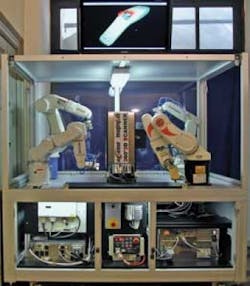VISION-GUIDED ROBOTICS: Graphical libraries ease robotic vision applications
Machine-vision software must be intricately combined with robotic programming languages to support vision-based robotic guidance systems. To successfully perform image inspection tasks, system integrators often combine specific imaging functions within vendor-specific software packages. The results are then used to call functions from robot programming languages to perform pick-and-place procedures, for example.
Depending on the task to be performed, system integrators can choose from a number of different robot types from a variety of manufacturers. Each manufacturer offers its own hardware-specific language to program these robots.
To ease the combination of vision and robots, many robotics manufacturers offer integrated solutions that pair third-party image-processing software with their robot controller software. Vision Guide 4.0 from Epson (Carson, CA, USA; www.robots.epson.com) makes use of Matrox Imaging Library (MIL) vision tools from Matrox Imaging (Dorval, QC, Canada; www.matrox.com/imaging) packaged with the Epson RC+ robot controller. Using a graphical programming environment, developers can then program vision-guided robotic functions within a single user interface.
“While this offers a single-point solution,” says Simone Rocchi, a design and development engineer with ImagingLab (Lodi, Italy; www.imaginglab.it), “those wishing to mix and match vision software and robots still need to seamlessly integrate both vision and software packages from multiple vendors.”
To alleviate this task for programmers using LabView graphical programming from National Instruments (NI; Austin, TX, USA; www.ni.com), ImagingLab has developed a Robotics Library that abstracts the low-level robotics programming languages of robot vendors Epson, Denso (Long Beach, CA, USA; www.densorobotics.com), Mitsubishi Electric (Cypress, CA, USA; www.mitsubishielectric.com), and KUKA (Clinton Township, MI, USA; www.kuka-robotics.com).
By abstracting low-level functions that are used to control motors, brakes, and move robot axes, system developers are presented with a unified graphical interface within LabView that is common to all these robot types. Developers who were required to be familiar with robot programming languages such as Epson’s RC+, Denso’s Wincaps, Mitsubishi’s RT ToolBox, and KUKA’s KRC, for example, now can use a single graphical program within LabView.
In its Robotics Library, ImagingLab uses the same protocols that are employed by Epson, Denso, and Mitsubishi for robot control. These are transmitted over the specific robot’s communications protocol. Because KUKA’s robot controller already features an embedded PC, the Robot Library uses a KUKA-supplied DLL and calls its functions from a client-based system running the Robot Library GUI on a second PC.
At AUTOMATICA 2010 in Munich, held in June, Aqsense (Girona, Spain; www.aqsense.com) and ImagingLab presented a multivendor, multibrand robot system integrating an Aqsense 360° 3D Scanner originally developed for food measurement (see “Laser triangulation system measures food products,” Vision Systems Design, January 2010).
In the demonstration, four anthropomorphic robots from Denso, Epson, KUKA, and Mitsubishi were used to feed and exchange different solid objects into the scanner (see figure). 3-D reconstruction of the object is then processed and displayed using Aqsense’s SAL3D library running in LabView. The 3-D computed results can be used for robot guidance, measurements, and quality part inspection.

